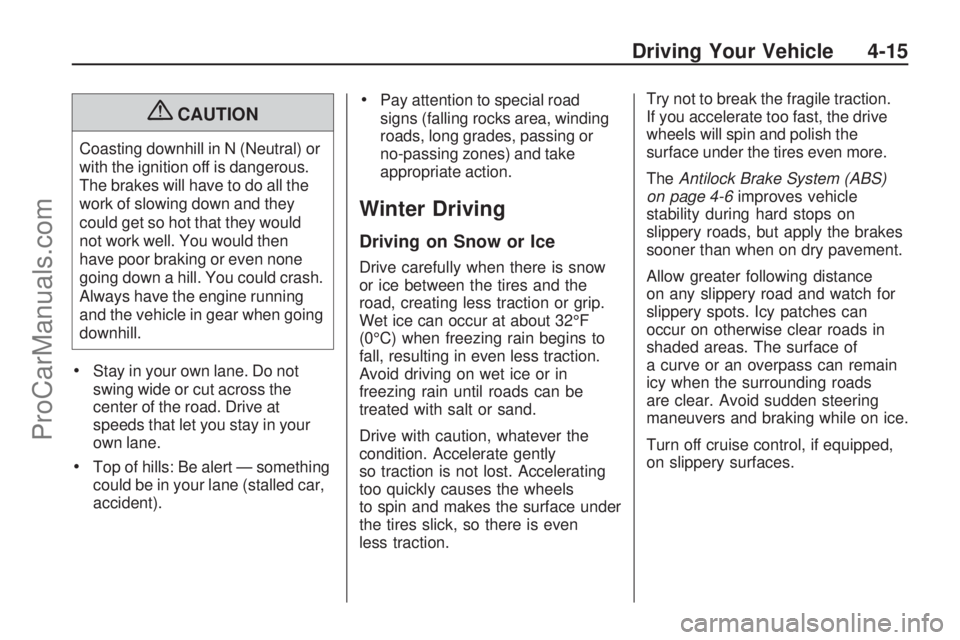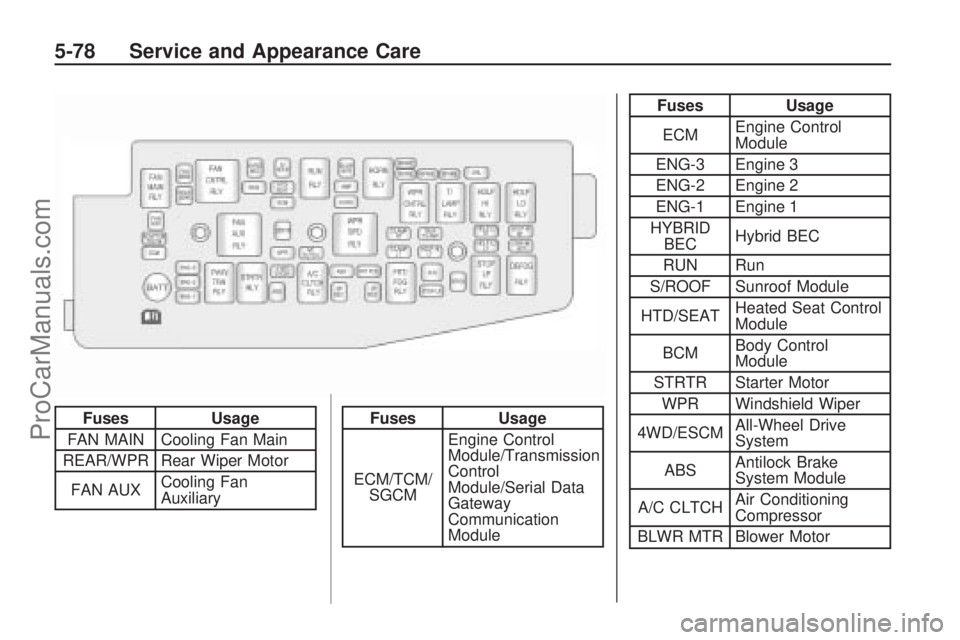ABS SATURN VUE HYBRID 2009 User Guide
[x] Cancel search | Manufacturer: SATURN, Model Year: 2009, Model line: VUE HYBRID, Model: SATURN VUE HYBRID 2009Pages: 346, PDF Size: 2.1 MB
Page 201 of 346

{CAUTION
Coasting downhill in N (Neutral) or
with the ignition off is dangerous.
The brakes will have to do all the
work of slowing down and they
could get so hot that they would
not work well. You would then
have poor braking or even none
going down a hill. You could crash.
Always have the engine running
and the vehicle in gear when going
downhill.
Stay in your own lane. Do not
swing wide or cut across the
center of the road. Drive at
speeds that let you stay in your
own lane.
Top of hills: Be alert — something
could be in your lane (stalled car,
accident).
Pay attention to special road
signs (falling rocks area, winding
roads, long grades, passing or
no-passing zones) and take
appropriate action.
Winter Driving
Driving on Snow or Ice
Drive carefully when there is snow
or ice between the tires and the
road, creating less traction or grip.
Wet ice can occur at about 32°F
(0°C) when freezing rain begins to
fall, resulting in even less traction.
Avoid driving on wet ice or in
freezing rain until roads can be
treated with salt or sand.
Drive with caution, whatever the
condition. Accelerate gently
so traction is not lost. Accelerating
too quickly causes the wheels
to spin and makes the surface under
the tires slick, so there is even
less traction.Try not to break the fragile traction.
If you accelerate too fast, the drive
wheels will spin and polish the
surface under the tires even more.
TheAntilock Brake System (ABS)
on page 4-6improves vehicle
stability during hard stops on
slippery roads, but apply the brakes
sooner than when on dry pavement.
Allow greater following distance
on any slippery road and watch for
slippery spots. Icy patches can
occur on otherwise clear roads in
shaded areas. The surface of
a curve or an overpass can remain
icy when the surrounding roads
are clear. Avoid sudden steering
maneuvers and braking while on ice.
Turn off cruise control, if equipped,
on slippery surfaces.
Driving Your Vehicle 4-15
ProCarManuals.com
Page 219 of 346

Parking on Hills
{CAUTION
Parking the vehicle on a hill with
the trailer attached can be
dangerous. If something goes
wrong, the rig could start to move.
People can be injured, and both
the vehicle and the trailer can be
damaged. When possible, always
park the rig on a �at surface.
If parking the rig on a hill:
1. Press the brake pedal, but do
not shift into P (Park) yet.
Turn the wheels into the curb if
facing downhill or into traffic
if facing uphill.
2. Have someone place chocks
under the trailer wheels.3. When the wheel chocks are in
place, release the regular
brakes until the chocks absorb
the load.
4. Reapply the brake pedal. Then
apply the parking brake and
shift into P (Park).
5. Release the brake pedal.
Leaving After Parking on
a Hill
1. Apply and hold the brake pedal
while you:
Start the engine
Shift into a gear
Release the parking brake
2. Let up on the brake pedal.
3. Drive slowly until the trailer is
clear of the chocks.
4. Stop and have someone pick up
and store the chocks.
Maintenance When Trailer
Towing
The vehicle needs service more
often when pulling a trailer.
SeeScheduled Maintenance on
page 6-3for more information.
Things that are especially important
in trailer operation are automatic
transmission �uid, engine oil,
axle lubricant, belts, cooling system
and brake system. It is a good
idea to inspect these before and
during the trip.
Check periodically to see that all
hitch nuts and bolts are tight.
Engine Cooling When Trailer
Towing
The cooling system may temporarily
overheat during severe operating
conditions. SeeEngine Overheating
on page 5-23.
Driving Your Vehicle 4-33
ProCarManuals.com
Page 288 of 346

Fabric/Carpet
Use a vacuum cleaner with a soft
brush attachment frequently to
remove dust and loose dirt.
A canister vacuum with a beater bar
in the nozzle may only be used
on �oor carpet and carpeted �oor
mats. For any soil, always try
to remove it �rst with plain water or
club soda. Before cleaning,
gently remove as much of the soil
as possible using one of the
following techniques:
For liquids: gently blot the
remaining soil with a paper towel.
Allow the soil to absorb into
the paper towel until no more can
be removed.
For solid dry soils: remove as
much as possible and then
vacuum.
To clean:
1. Saturate a lint-free, clean white
cloth with water or club soda.
2. Wring the cloth to remove excess
moisture.3. Start on the outside edge of the
soil and gently rub toward the
center. Continue cleaning, using
a clean area of the cloth each
time it becomes soiled.
4. Continue to gently rub the soiled
area until the cleaning cloth
remains clean.
5. If the soil is not completely
removed, use a mild soap
solution and repeat the cleaning
process that was used with
plain water.
If any of the soil remains, a
commercial fabric cleaner or spot
lifter may be necessary. When a
commercial upholstery cleaner or
spot lifter is to be used, test a small
hidden area for colorfastness �rst. If
the locally cleaned area gives any
impression that a ring formation may
result, clean the entire surface.
After the cleaning process has been
completed, a paper towel can be
used to blot excess moisture
from the fabric or carpet.
Leather
A soft cloth dampened with water
can be used to remove dust. If
a more thorough cleaning is
necessary, a soft cloth dampened
with a mild soap solution can
be used. Allow the leather to dry
naturally. Do not use heat to
dry. Never use steam to clean
leather. Never use spot lifters or
spot removers on leather. Many
commercial leather cleaners
and coatings that are sold to
preserve and protect leather may
permanently change the appearance
and feel of the leather and are not
recommended. Do not use
silicone or wax-based products, or
those containing organic solvents to
clean the vehicle’s interior because
they can alter the appearance
by increasing the gloss in a
non-uniform manner. Never use
shoe polish on leather.
5-68 Service and Appearance Care
ProCarManuals.com
Page 298 of 346

FusesUsage
FAN MAIN Cooling Fan Main
REAR/WPR Rear Wiper Motor
FAN AUX Cooling Fan
AuxiliaryFuses
Usage
ECM/TCM/ SGCM Engine Control
Module/Transmission
Control
Module/Serial Data
Gateway
Communication
Module
Fuses
Usage
ECM Engine Control
Module
ENG-3 Engine 3
ENG-2 Engine 2
ENG-1 Engine 1
HYBRID BEC Hybrid BEC
RUN Run
S/ROOF Sunroof Module
HTD/SEAT Heated Seat Control
Module
BCM Body Control
Module
STRTR Starter Motor WPR Windshield Wiper
4WD/ESCM All-Wheel Drive
System
ABS Antilock Brake
System Module
A/C CLTCH Air Conditioning
Compressor
BLWR MTR Blower Motor
5-78 Service and Appearance Care
ProCarManuals.com
Page 299 of 346

Fuses Usage
AMP Ampli�er
HORN Horn
ABSAntilock Brake
System Module
I/P BECInstrument Panel
Bussed Electrical
Center
FRT FOG Front Fog Lamps
I/P BECInstrument Panel
Bussed Electrical
Center
DRLDaytime Running
Light
T/LAMP RTRight Turn and
Parking Lamps
T/LAMP LTLeft Turn and
Parking Lamps
TRLR
T/LAMPTrailer Parking
Lamps
HDLPHILTPassenger Side
High-Beam
Headlamp
STOP LP Stoplamps
DEFOG Defroster FogFuses Usage
HDLP
LO RTDriver Side
Low-Beam
Headlamp
HDLP
LO LTPassenger Side
Low-Beam
Headlamp
HDLP
HI RTDriver Side
High-Beam
Headlamp
OSRVM
HTROutside Rearview
Mirror Heating
Relays Usage
FAN MAIN
RLYCooling Fan Main
Relay
FAN CTRL
RLYCooling Fan Control
Relay
FAN AUX
RLYCooling Fan
Auxiliary Relay
PWR/TRN
RLYEngine Control
Module/CAM,
Canister, Injectors,
Electronic Throttle
Control Relay
Relays Usage
STRTR
RLYStarter Relay
RUN RLY Run Relay
A/C CLTCH
RLYAir Conditioning
Compressor Relay
WPR SPD
RLYWindshield Wiper
Speed Relay
HORN RLY Horn Relay
WPR
CNTRL
RLYWindshield Wiper
Control Relay
T/LAMP
RLYParking Lamp Relay
HDLP
HI RLYHigh-Beam
Headlamp Relay
HDLP
LO RLYLow-Beam
Headlamp Relay
FRT FOG
RLYFront Foglamp
Relay
STOP
LP RLYStoplamp Relay
DEFOG
RLYDefogger Relay
Service and Appearance Care 5-79
ProCarManuals.com
Page 335 of 346

A
About Driving Your Vehicle......... ii
Accessories and
Modi�cations...................... 5-3
Accessory Power Outlets......3-16
Adding Equipment to Your
Airbag-Equipped Vehicle....1-55
Additives, Fuel...................... 5-5
Add-On Electrical
Equipment.......................5-75
Air Cleaner/Filter, Engine.......5-15
Air Conditioning...................3-17
Airbag
Passenger Status
Indicator.......................3-26
Readiness Light................3-25
Airbag System.....................1-41
Adding Equipment to
Your Airbag-Equipped
Vehicle........................1-55
How Does an Airbag
Restrain?.....................1-47
Passenger Sensing
System........................1-49Airbag System (cont.)
Servicing Your
Airbag-Equipped
Vehicle........................1-54
What Makes an Airbag
In�ate?........................1-47
What Will You See After an
Airbag In�ates?.............1-48
When Should an Airbag
In�ate?........................1-45
Where Are the Airbags?.....1-44
Antenna, Fixed Mast............3-84
Antenna, XM™ Satellite
Radio Antenna System......3-84
Antilock Brake
System (ABS).................... 4-6
Antilock Brake, System
Warning Light...................3-28
Appearance Care
Aluminum Wheels.............5-72
Care of Safety Belts..........5-69
Chemical Paint Spotting.....5-73
Cleaning Exterior Lamps/
Lenses........................5-70
Fabric/Carpet...................5-68Appearance Care (cont.)
Finish Care......................5-70
Finish Damage.................5-73
Instrument Panel, Vinyl,
and Other Plastic
Surfaces......................5-69
Interior Cleaning...............5-66
Leather...........................5-68
Sheet Metal Damage........5-73
Tires...............................5-72
Underbody Maintenance....5-73
Washing Your Vehicle........5-69
Weatherstrips...................5-69
Windshield and Wiper
Blades.........................5-71
Appointments, Scheduling
Service............................. 7-7
Audio System......................3-56
Audio Steering Wheel
Controls.......................3-82
Chime Level Adjustment....3-84
Fixed Mast Antenna..........3-84
Radio Reception...............3-83
Setting the Clock..............3-56
Theft-Deterrent Feature......3-82
XM™ Satellite Radio
Antenna System............3-84
INDEX i-1
ProCarManuals.com
Page 340 of 346

I
Ignition Positions..................2-14
Infants and Young Children,
Restraints........................1-25
In�ation - Tire Pressure.........5-43
In�ator Kit, Tire....................5-59
Instrument Panel
Brightness.......................3-14
Cluster............................3-23
Overview........................... 3-4
Intermediate Voltage Devices
and Wiring.......................5-74
J
Jump Starting......................5-28
K
Keyless Entry System............ 2-3
Keys.................................... 2-2
L
Labeling, Tire Sidewall..........5-39
Lamp
Malfunction Indicator.........3-30Lamps
Dome .............................3-14
Reading..........................3-14
Lap-Shoulder Belt................1-17
LATCH System for Child
Restraints........................1-31
License Plate Lamps............5-37
Liftgate
Carbon Monoxide............... 2-8
Light
Airbag Readiness.............3-25
Antilock Brake System
(ABS) Warning..............3-28
Brake System Warning......3-27
Change Engine Oil...........3-33
Charging System..............3-27
Cruise Control..................3-33
Engine Coolant
Temperature Warning.....3-29
Fuel Economy..................3-35
Highbeam On...................3-34
Low Fuel Warning.............3-34
Low Washer Fluid
Warning.......................3-34
Oil Pressure.....................3-33
Passenger Airbag Status
Indicator.......................3-26Light (cont.)
Safety Belt Reminders.......3-24
Security...........................3-33
StabiliTrak
®/Traction
Control System (TCS)
Warning Light...............3-28
Tire Pressure...................3-29
Light, Auto Stop Mode..........3-35
Lighting
Entry..............................3-14
Lights
Exterior Lamps.................3-12
Flash-to-Pass..................... 3-7
High/Low Beam Changer..... 3-7
Loading Your Vehicle............4-18
Lockout Protection................. 2-7
Locks
Automatic Door Lock.......... 2-7
Automatic Door Unlock........ 2-7
Delayed Locking................. 2-6
Door ................................. 2-6
Lockout Protection.............. 2-7
Power Door....................... 2-6
Rear Door Security Locks.... 2-7
Loss of Control....................4-11
Low Fuel Warning Light........3-34
Low Washer Fluid Warning
Light...............................3-34
i-6 INDEX
ProCarManuals.com